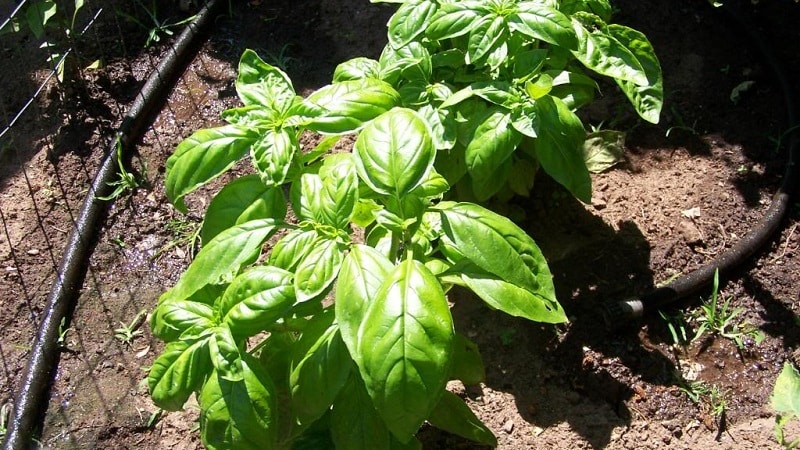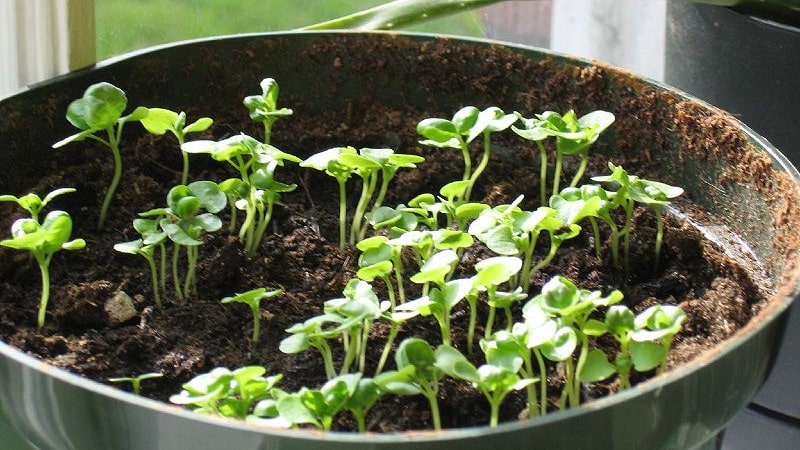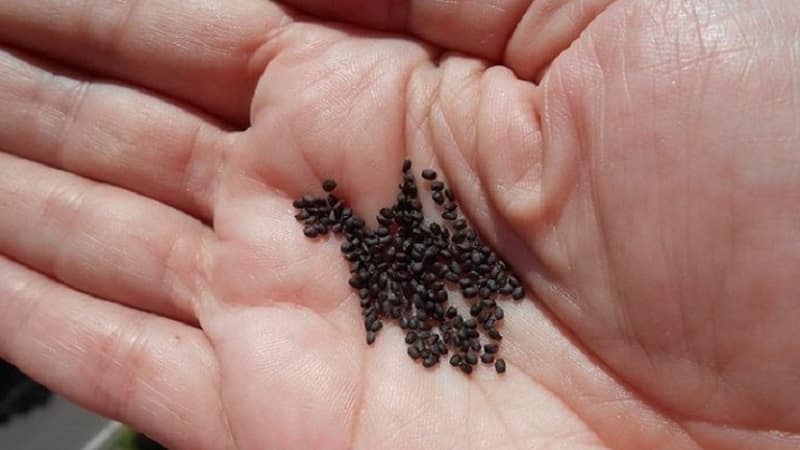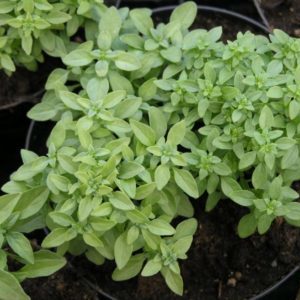Transplanting and growing basil at home
Basil is one of the spices that is successfully cultivated not only in the open ground, but also at home. Knowing the rules for planting and growing plants in a pot will help you achieve the desired result and get a rich harvest of spicy herbs. In this article we will tell you how to grow basil on a windowsill: how to plant seeds, root cuttings, replant adult bushes and what are the nuances of care.
How to grow basil at home

Basil grows well in loose, light and fertile soil with good moisture permeability, aeration and medium to neutral acidity (pH 6.5-7.2).
At home, you can use a ready-made substrate intended for seedlings, or prepare a soil mixture yourself by mixing one part of humus and two parts of peat or coconut fiber. A mixture of garden soil and vermicompost, taken in a ratio of 1:4, is also suitable for this.
Before use, the soil is disinfected: calcined in the oven for 40-60 minutes at a temperature of at least +180°C, scalded with boiling water, poured with potassium permanganate or Fitosporin solution.
The choice of container depends on the type of cultivation. If we are talking about sowing in a permanent place, use pots with a depth of at least 10-15 cm; Special containers with cells are suitable for growing seedlings.
Reference. The most suitable varieties of basil for transplanting and growing at home: Mint, Clove aroma, Baku, Spoon-shaped, Marquis, Dwarf, Troll, Lemon, Small-leaved, Tufted, Yerevan.
Selecting a location
Basil is a light-loving plant, so containers with it are placed in the most illuminated places, protected from drafts and cold winds. The best option is window sills of south-west or south-east windows.
The minimum duration of daylight hours should be 12, and ideally 14-16 hours. In autumn and winter, when there is not enough natural light, fluorescent or phytolamps are used, placing them 10-12 cm from the plantings.
The containers in which basil grows are periodically turned towards the light source to illuminate the bushes evenly.
Indoor conditions

Being a heat-loving plant, basil grows well at temperatures of +22...+25°C, the minimum temperature is +18...+20°C.
The crop prefers high humidity, so in the summer and in the autumn-winter period, during the heating season, the leaves of the plant are sprayed twice a day with water at room temperature. To combat dry air, pots of basil are placed in a container with damp pebbles or expanded clay and containers of water are placed nearby.
Important! Growing basil in unfavorable conditions leads to drying and curling of the leaves, loss of aroma and beneficial properties of the plant.
Methods for planting basil
At home, basil is grown in three ways: from seeds, by rooting cuttings or by transplanting an adult bush from open ground in a pot.
Transplanting from the garden

To protect the plant from frost, at the beginning of autumn it is dug up from the garden bed and planted in a pot for further cultivation.
Transplant process:
- Prepare a container with a volume of 2-3 liters.
- A drainage layer about 3 cm thick made of expanded clay or broken brick is poured onto the bottom.
- Pour soil on top, make a depression in it and pour settled water at room temperature into it.
- Water the bush chosen in the garden bed to make the soil softer, and dig it out of the ground along with a lump of earth.
- Carefully, without damaging the root system, transfer the bush to the pot.
- Fill the voids with earth and compact it.
After transplantation, remove all damaged parts of the plant, water it and place it in a well-lit, warm room.
Growing from seeds at home

Germinating basil seeds is not a very simple matter, because they are covered with a hard and dense shell that slows down germination. Therefore, before sowing planting material is soaked for a day in warm (+35...+40°C) water, then dipped in a solution of potassium permanganate for 30 minutes and dried on a paper napkin.
How to sow basil in a pot:
- Drainage is placed at the bottom of the prepared container, a layer of soil mixture is poured on top so that 3-4 cm remains to the edges, the surface is leveled and the soil is watered.
- Seeds are sown every 2-2.5 cm, deepening by 1 cm.
- Cover the container with plastic wrap and put it in a warm (+20…+25°C) bright place.
- The film is periodically removed to ventilate. landings.
- Before emergence, watering is not carried out so as not to wash out the seeds. Instead, the soil surface is sprayed with warm (+30°C) water.
Shoots appear in 7-15 days.At this time, the shelter is removed, and the temperature in the room is reduced to +17...+20°C to prevent the sprouts from stretching.
In case of thickening, the seedlings are gradually thinned out, alternately removing the weakest sprouts until the distance between them reaches 7-10 cm.
When the height of the seedlings is 5-7 cm, approximately 2-4 cm of soil is poured into the container to strengthen the shoots.
Reference. Nutritional maturity of plants occurs in 40-60 days.
In summer, plants are watered and sprayed every 1-2 days, in winter - twice a week. Fertilizers are applied monthly, the air temperature is maintained within +20…+25°C.
Growing from cuttings
Cuttings are a simple method that guarantees quick production of basil greens. To do this, cut off the top of the stem and side shoots from an adult bush with a sharp knife so that the length of the cutting is at least 5 cm.
For rooting, planting material is placed in a container with water or damp soil. In the first case, the roots appear after 7-10 days, after which the cuttings are planted in loose soil; in the second - after 2-3 weeks. As the plants grow, they are transplanted into larger containers by transshipment.
Caring for basil in a pot

In order for basil to delight you with a rich harvest of juicy spicy leaves, it is important to provide it with proper care. In addition to prolonged lighting, comfortable temperature and high humidity, the plant needs regular watering, fertilizers, pruning and protection from diseases and pests.
Watering and fertilizing
Basil is a moisture-loving plant; insufficient watering leads to loss of leaf turgor. In this case, excessive moisture causes the development of root rot.
Watering is carried out as needed, when the substrate dries to a depth of 1-2 cm (on average, every 1-2 days), using settled or filtered water at room temperature.
After watering, approximately once every 2-3 days, the soil is loosened. This prevents the formation of a dry crust on the surface and improves the access of moisture and oxygen to the roots.
Fertilizing is applied once a month using universal complex fertilizers (Agricola, Agrolife, Energen, Rost). The application of liquid fertilizers is combined with watering; dry granules are scattered on damp soil.
Reference. The optimal time to apply fertilizer is after pruning the bushes.
Pinching and trimming
Without pruning and pinching, basil forms 1 straight stem and produces a poor harvest. It is important not to forget about the need to form a crown in order to stimulate the formation of lateral shoots.
When the plants form 6-8 true leaves and reach a height of 15-18 cm, pinching is carried out. Young shoots are shortened in the same way when their length reaches 10-12 cm. When flower stalks appear, they are immediately removed.
Prevention of diseases and pests
Despite good immunity to diseases and pests, basil can be affected by:
| Disease, pest | Signs | Treatment, prevention |
| Blackleg | The fungus attacks the root collar. The stem and its base become soft and thin, turning black. The bush turns yellow and dies. | Affected plants are dug up along with a lump of earth and destroyed. The soil is watered with potassium permanganate or fungicidal preparations (Fitosporin, Tiovit, Jet or Topaz). |
| Fusarium | Dark, almost black spots appear on the leaves. Over time, the leaf blades become completely black, dry out and curl. | At the early stage of the disease and for prevention, plants and substrate are sprayed with a decoction of onion peels. In the later stages, all affected parts of the basil are removed, and the bush is treated with fungicides, such as Topaz, Trichovit or Gamair. |
| Gray rot | First, on the lower leaves, and over time, on all leaves, dry spots of gray-brown color appear, which later begin to get wet and become covered with gray fluff. | |
| Aphid | Leaves and bushes dry out, shoots do not develop. Sugary secretions and a dark coating are noticeable on the surface of the plant. | Plants are treated with insecticidal preparations: “Karbofos”, “Bankol”, “Akarin” or “Aktellik”. |
| Meadow, or field, bug | The leaf blades become deformed, become covered with whitish spots, gradually acquire a brown color and die. |
Conclusion
Growing basil at home – it’s not a difficult matter. The main thing is to choose a suitable container and soil, provide the plant with optimal temperature conditions, monitor the level of humidity and the length of daylight hours, and water regularly, preventing the soil from drying out. An undeniable advantage of cultivating basil on a windowsill is the ability to obtain fresh herbs throughout the year.